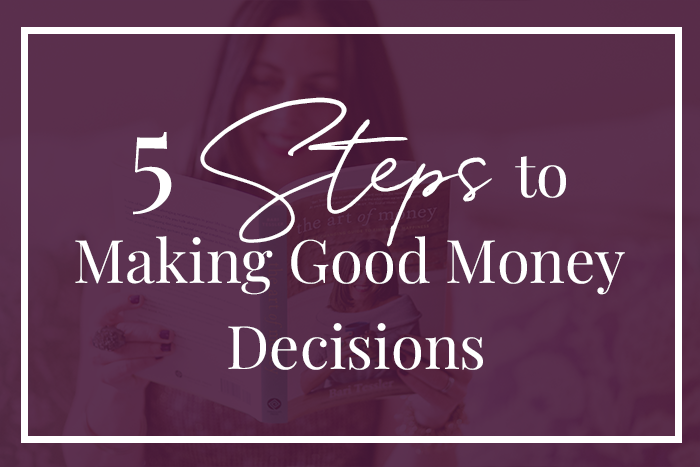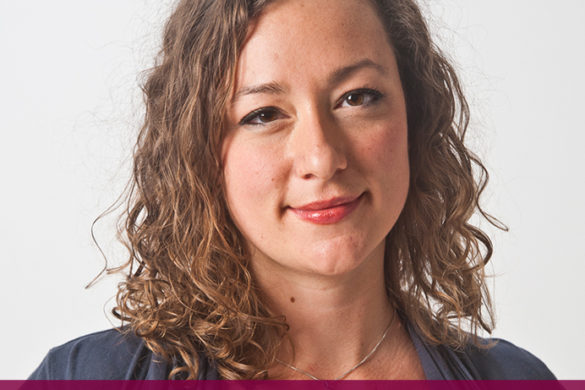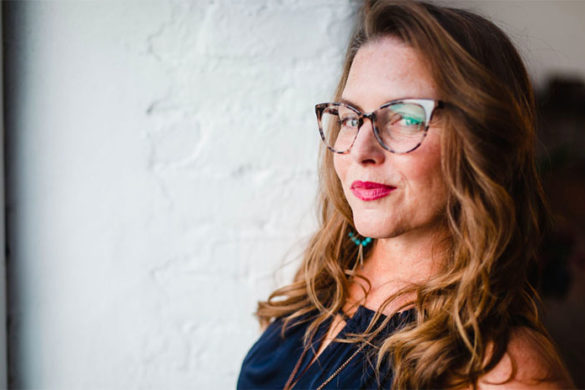Dear Money Adventurer,
The Art of Money year-long money school registration will be closing soon and we’d love to have you join us.
If you’re reading this and you’re still trying to make a decision about whether or not to join us yourself, well…I have some help for you.
See, the decision you’re trying to make now is a money decision: Should you spend money on improving your relationship with money?
Feels like a bit of a paradox, right?
If it feels a little tangly in your mind, stick with me because I want to use this moment as a chance to teach you one of the most important skills around money. I’m going to take you through a step-by-step process of how to make a good money decision…about anything.
It could be whether to buy a new couch, or a new pair of boots, or a car, or, yes, an online program about making your relationship with money better.
This is the same process that my husband and I use in our lives, and it’s the same process I teach in my program (though the version here is simplified.)
How to Make a Good Money Decision in 5 Easy Steps
Step One: The Numbers.
This is the most practical, cut-and-dried factor to consider.
Do you have enough money right now to make this purchase?
Simply reading that question might bring up some fear for you. You might not actually know how much money is in your bank account right now, or how much you’re earning, spending, and saving each month.
You might be terrified to even peek at your numbers — and you aren’t alone. This is way more common than you might think! And it’s a huge, paralyzing roadblock between you and a clear money decision.
Believe it or not, people “go unconscious” about money regardless of how much or how little they earn. Yep! This pattern cuts right across the spectrum of income and socioeconomic status.
See, this actually isn’t about the numbers. It’s about your relationship with your numbers.
Plus, “having enough money” is a pretty subjective issue.
Some people who are just making ends meet or living on a tight budget may choose to do whatever it takes to invest in something really important to them. (More on how to decide what’s “important” in a bit).
On the other hand, people who have more than enough money to satisfy all of their needs and desires might still feel enormous pressure around making money decisions.
So … what’s your relationship with your numbers?
If you really want to join The Art of Money but aren’t sure if you can swing it, you could find a friend to join you on the journey. The two of you can join at the AOM Buddy rate of 3 monthly payments of $440 and split it, so you’d each only have to make three monthly payments of $220 (versus $312 as a solo money adventurer.).
Now, if you have no idea what your numbers are, and are afraid to even look at them, consider this: The Art of Money will gently teach you how to do just that.
Step Two: The Timing.
Is NOW the right time for you to make this investment in yourself?
In our Art of Money example, you might ask yourself:
Is your relationship to money calling (or screaming) for support right now?
Have you been longing for this kind of support for months or even years?
Has your need for money healing, practices, and guidance gotten LOUDER recently?
Are you in, recovering from, or about to face a big life event — like getting married, having a baby, changing career, starting a business, grieving a loss, or going through another big transition in your life? These experiences can catapult us into a money initiation.
Do you feel ready to do this work?
How does The Art of Money year-long money school line up with the timing of your unique money story?
Step Three: The Value.
This. Is. The. Biggie.
Is the thing or experience you’re thinking of buying valuable to you? In our example, does the Art of Money program feel valuable to you?
If it does, how valuable? Are you willing to spend your money to reflect this value?
It’s often difficult to pinpoint or quantify the exact value of a purchase. My work often falls into this category, as it’s difficult to know ahead of time (or from the outside) just how deep and sweeping the transformation and benefits you’ll receive will be.
Sometimes we have to dig deep to decide for ourselves how valuable a potential investment is to us.
When it comes to The Art of Money, people often report massive shifts … which are subtle at first and then get expressed as external change over time.
Here are some of the tangible and intangible benefits you can expect from The Art of Money. As you read these, check in with yourself. Imagine each point becoming a truth in your life. How much would these be worth to you?
Letting go of old, unhelpful patterns, traumas, and shame around money.
Less fights about money with your sweetie and more intimate, fun (and even sexy!) money conversations.
Learning the language and systems of money. (This is so empowering.)
Tuning into what truly matters to YOU and aligning these values with your money habits.
Personalized daily, weekly, monthly, and annual money practices so you can see how much money is flowing in and out of your life, and where.
Tools to make “money stuff” more creative + playful + meaningful to you.
Take a deep breath. Notice how your body feels, right now. Ask yourself:
What are these things worth to me? How would my life be different or better if I had all of these things?
Follow your values.
Once you’re clear on how valuable something is (or isn’t) to you, the choice is almost made for you.
Step Four: The Cost of Not Buying This.
You’ve already explored what you expect/hope this experience will bring you — the value. This is the opposite of that.
What will it cost you to NOT make this investment in yourself?
How is NOT doing this work hurting you, your career, and your relationships?
How much will it cost you over the next year?
What’s the cost of staying right where you are in your relationship to money?
Here are some common, painful consequences I’ve seen:
- Shame, guilt, fear, or anxiety about your financial situation.
- Conflict with your parents or your kids around money (whether painfully unspoken or jarringly loud.)
- Money wasted on bank charges, late fees, unpaid taxes, and more — because your financial house isn’t in order.
- Career stress, confusion, or paralysis because you’re not sure how to move forward financially.
- Neglecting your most cherished dreams and values — because you can’t afford to invest in them (or aren’t sure if you can or “should”.)
What would it be worth to you to banish these things from your life, for good?
Step Five: The Intention.
Is this a self-loving decision? Are you ready to receive the value of this investment?
Have you ever bought a fancy grill, dreaming of all the quality time you’d spend with family and friends outside … and then never used it? Or signed up for an online class, but missed the calls and skipped out on the practices?
A lot of people beat themselves up about this. We spend our money on something we think we’ll use and love … and then let it rot. Ouch.
The keys here are investing with intention and being ready to receive.
If you’re prepared to gently, lovingly hold yourself accountable for receiving the value of this investment…
If you feel empowered, trusting, and loving towards yourself in making this investment…
If you’re prepared to invest not only your money, but your mind, your heart, your time, and your energy, as well…
Then everything is aligned for you to receive a powerful return on your investment.
So. Deep breath. Check in with yourself.
Look at your numbers. Consider the timing. Weigh the value. Reflect on your intentions. Is this your time?
Only YOU can know.
I wish you a grounded, clear-headed, savvy money decision. Tune into what matters the very most for YOU, and this point in your precious life story. And if the time is right, I’ll see you inside the program.
With my dearest wishes,


P.S. Just a gentle head’s up while you turn inward with this money decision: Registration for The Art of Money closes on Thursday, April 20th. You can find out all about The Art of Money program right here. And if you’ve got questions, we’ve got the answers.
“I am so grateful to the Me of 2018 that took the plunge. My money life was changed forever. Now I experience peace instead of fear, flourishing instead of scarcity, and confidence instead of insecurity.”
~PattieBelle Hastings





